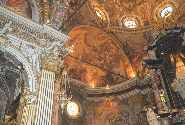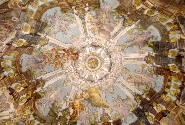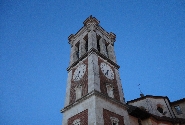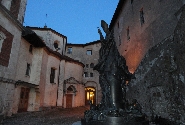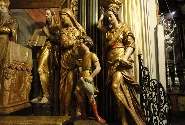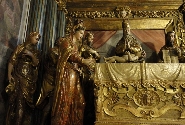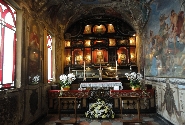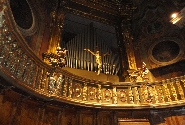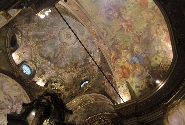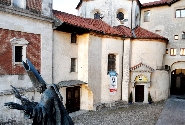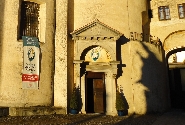The Village, the Shrine and the convent
THE VILLAGE OF SACRO MONTE DI VARESE
The history of the Sacro Monte revolves around the Shrine of Santa Maria del Monte sopra Varese, which was first recorded in a document from 922 although its construction dates back to an earlier time.
According to tradition, it was St. Ambrose who brought the worship of the Virgin Mary to the mountain, later called ‘sacred’, in the 4th century, as a token of gratitude for winning a victory over the Arian heretics by an extant tower within the monastery precincts. The tower, a Late Roman building which used to be a military fortress before being sanctified, reflects the strategic importance of the site to spot people approaching from the north. Some archaeological excavations carried out during the restoration works of the crypt of the shrine, which ended in October 2015, revealed evidence of a 5-6th century church that was knocked down to be replaced with a new one (9-10thcentury). The hypothesis that the crypt coincided with the chancel of the Early Middle Ages church has also been confirmed. Due to the increasing number of pilgrims, a bigger church was constructed on this site in the Romanesque period. In 1472 some works started under the duke of Milan Galeazzo Maria Sforza and the church was restored to its present shape, which includes three aisles and a chancel with three apsis. The nave was extended in length and the narthex removed in the 17thcentury instead.
The village nestles around the church. Its secular buildings and the church grew symbiotically over the Middle Ages. On the architectural side, it is extremely hard to distinguish the first constructions from the church and the adjacent rooms at first sight. On the practical side, the first houses were built to host the workers of the shrine and those who were involved in managing the pilgrims. Worth noticing is the underground passage which runs under the presbytery and other rooms annexed to the shrine, connecting the last part of the chapel trail, under the bell tower, with Piazzetta Monastero, where you can find the convent, the shrine and the Museo Baroffio e del Santuario. This picturesque passage, which is still in use today, includes some windows of different shapes and sizes through which visitors can enjoy stunning views of the surrounding landscape. Some evidences of construction, which have not yet been properly interpreted, show its complex history.
VISIT TO THE SACRO MONTE SHRINE
The present shrine is the result of various building phases, as confirmed by archaeological excavations undertaken during the restoration of the crypt, which ended in October 2015.
- A church belonging to the Carolingian-Ottonian period (9-10th century) with a semi-circular apse at its east end;
- A new Romanesque church, which was extended to the west and raised high on a pre-existing church so that the chancel could be turned into a crypt, with a staircase leading down into it.
- The considerable restoration works of 1472-1476 by architects Bartolomeo da Cremona called “Il Gadio” and Benedetto Ferrini da Firenze who, by the will of the duke of Milan Galeazzo Maria Sforza and his ancestors, enlarged the Romanesque church by adding two more aisles and rebuilding the three-apsed chancel.
The rich decorative program commissioned by the signori of Milan for the most important Marian shrine of their duchy is almost lost and the Shrine of Santa Maria del Monte sopra Varese is currently adorned with 17th-century magnificent frescoes by Giovan Mauro della Rovere, Giovanni Paolo Ghianda, Salvatore Bianchi and the Lampugnani, which are framed by rich Baroque stucco decorations. The impressive high altar, where the 4th-century worshipped wooden statue of the Virgin with the Child stands, was made in the second half of the 17th century.
Works to beautify the interior of the church in the 17th century are related to the great challenge of the Pilgrims’ Trail, with its fourteen chapels dedicated to the mysteries of the Rosary.
THE SACRO MONTE CONVENT
Next to the shrine, it is located the active Convent of the Romite Ambrosiane, which was founded by Blessed Catherine of Pallanza and Giuliana Puricelli. It was established in 1474, when pope Sixtus V approved it in a papal bull, according to the Augustinian principles and the rules of the ancient Ordine di S.Ambrogio ad Nemus. Two years later, the first five Romite nuns took vows and Catherine became abbess of the group. She was born in Pallanza from a rich and noble family but lived in Milan and in the mid-1400s she moved to Sacro Monte to live as a hermit in the shrine.
She was soon joined by Giuliana from Verghera-Busto Arsizio, a woman of humble origins, and other three women willing to share a common life based on penance, contemplation and assistance to the pilgrims visiting the shrine. Catherine and Giuliana were beatified in 1769, although people had worshipped them since their death. In 1798 the convent was abolished by the Cisalpine Republic and most of its possessions were confiscated, scattered and destroyed. The nuns retained their building as a non-religious residence until 1822, when they were allowed to adopt the rule of a convent committing themselves to opening a school and a boarding school for girls in exchange. In 1969 they could close the school to devote themselves to the initial contemplative life.
The Romite nuns, still living next to the shrine, spend their day praying and meditating, studying voice, Ambrosian texts and the liturgy; they enhance knowledge of their history and publish some texts, they grow food to be self-sufficient and do restoration work in their workshop, which is also open to external requests. They also provide spiritual support and lodging to those who worship the newly-restored Centro di Spiritualità.
The visit continues with the Chapels trail and the Crypt.




